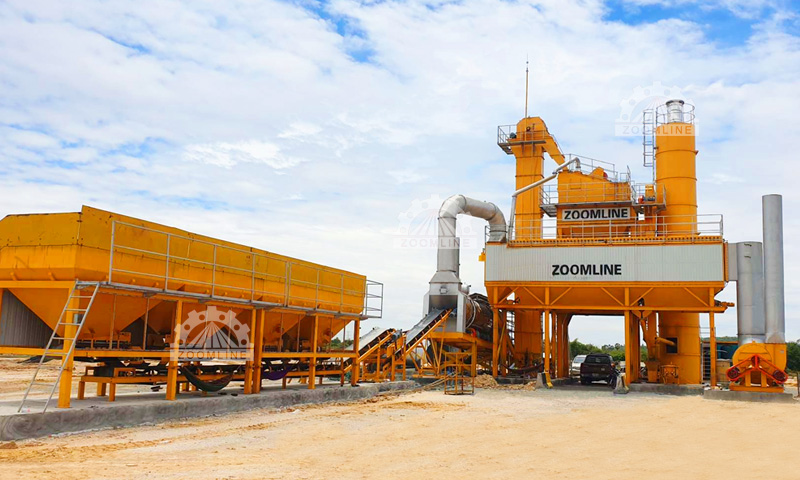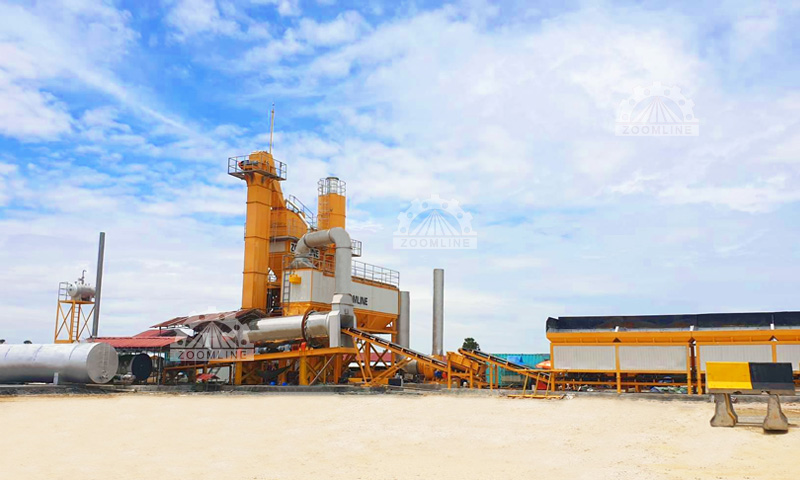Against the backdrop of rapid global infrastructure development, asphalt—a core material in road construction—and its production facilities, asphalt mixing plants, are increasingly drawing attention for their environmental impact. From air and water resources to noise pollution and carbon footprints, asphalt mixing plants face significant environmental challenges while supporting transportation networks. This article will comprehensively analyze the environmental impact of asphalt mixing plants, delve into the environmental measures currently being implemented by the industry, and explore future trends, aiming to provide insights for promoting the green transformation of asphalt production.
An asphalt mixing plant is a specialized piece of equipment that mixes and heats raw materials such as sand, gravel, and asphalt in specific proportions to produce asphalt mixture. It is a critical component in the road construction supply chain. The core operational process includes raw material storage, drying and heating, screening and material distribution, asphalt blending and mixing, and other steps, ultimately producing asphalt mixture that meets engineering standards.
From a technical perspective, asphalt mixing plants are primarily categorized into two main types: batch-type mixing plants and drum-type mixing plants, which exhibit significant differences in environmental impact. Batch-type mixing plants operate on a ‘batch processing’ model, where raw materials are first dried and heated before entering the mixing drum to be blended with asphalt. This process tends to generate concentrated dust and exhaust emissions during heating, but it facilitates precise control of proportions and quality; Drum-type mixing plants, on the other hand, perform drying and mixing simultaneously. Raw materials are heated and mixed with asphalt inside the drum, resulting in relatively lower energy consumption. However, exhaust gas emissions are more dispersed, making collection and treatment more challenging. Understanding the operational characteristics of different types of mixing plants is the foundation for analyzing their environmental impacts.

Air pollution is one of the most pressing environmental issues in asphalt production. The heating process generates a large amount of pollutants, mainly including particulate matter (PM2.5, PM10), volatile organic compounds (VOCs), carbon monoxide (CO), and nitrogen oxides (NOx). Among these, VOCs and nitrogen oxides are prone to photochemical reactions under sunlight, leading to ozone pollution; particulate matter can cause respiratory diseases, posing a long-term threat to the health of nearby community residents and front-line workers.
To address air pollution, modern asphalt mixing plants have widely adopted various pollution control technologies. Bag-house dust collectors use high-performance filter media to capture dust particles, achieving dust removal efficiency of over 99%; exhaust gas scrubbers utilize chemical solutions to absorb VOCs and acidic gases, effectively reducing the emission of toxic substances; some advanced companies have also introduced thermal regeneration technology, which recovers waste heat from flue gas to reduce fuel consumption and minimize pollutant generation at the source. The combined application of these technologies has significantly enhanced the environmental performance of asphalt production.
Although asphalt mixing plants are not considered high-water-consuming industries, water resource management during the production process remains critical. The demand for cooling water, equipment cleaning water, and other uses can place significant pressure on local water resources, particularly in arid regions where water efficiency must be prioritized. Even more concerning is the risk of water pollution — if asphalt, solvents, and cleaning wastewater leaked during production are discharged without treatment, they may contaminate soil and water bodies, disrupting ecological balance.
To address this issue, a standardized wastewater treatment system has become standard equipment for modern asphalt mixing plants. Through multi-stage treatment processes such as sedimentation tanks to remove suspended impurities, oil-water separators to separate oily substances, and filtration systems to purify water quality, wastewater can be recycled for use in equipment cooling or site cleaning, thereby reducing fresh water consumption and preventing pollution discharge. Some companies have also established rainwater collection systems to divert initial rainfall into treatment facilities, preventing surface runoff from carrying pollutants and spreading them.
Noise from asphalt mixing plants primarily originates from the operation of mechanical equipment such as crushers, drying drums, fans, and loaders. Long-term noise levels can reach 85-100 decibels, far exceeding the 55-decibel environmental standard for residential areas. Prolonged exposure to high noise levels may not only cause hearing damage among nearby residents but also lead to psychological issues such as insomnia and anxiety, thereby impacting quality of life.
To alleviate noise disturbances, the industry has implemented several targeted measures. In equipment selection, low-noise models are prioritized, and high-noise components are fitted with soundproof enclosures and vibration-reduction devices; in plant layout, high-noise equipment is concentrated in areas distant from residential zones, and sound barriers are installed to block noise transmission paths; in operational management, production schedules are optimized to avoid nighttime operations, minimizing disturbances to residents’ rest. These comprehensive measures can reduce boundary noise levels by 20-30 decibels, significantly improving the surrounding sound environment.
Asphalt production is a high-energy-consuming industry, and its heavy reliance on energy during the heating process makes it a significant source of carbon emissions. Traditional asphalt mixing plants primarily rely on fossil fuels such as coal and heavy oil, which not only have low energy efficiency but also produce large amounts of carbon dioxide. Statistics show that the carbon emissions from producing 1 ton of asphalt mixture can reach 0.1-0.15 tons, making the industry’s overall carbon footprint significant.
In recent years, energy structure transformation and the application of energy-saving technologies have become the core pathways for the industry’s carbon reduction efforts. On one hand, some companies are gradually promoting the use of clean energy sources like natural gas to replace high-pollution fuels. On the other hand, the widespread adoption of waste heat recovery systems reuses thermal energy from flue gas for raw material preheating, improving energy utilization rates by 15%-20%. More cutting-edge explorations include solar-assisted heating and biomass fuel applications, though currently low in adoption rates, they provide direction for low-carbon production. Additionally, regularly conducting energy audits and optimizing production processes can effectively reduce energy consumption per unit of product.
Asphalt mixing plants generate various types of waste during production, including packaging material waste, waste asphalt mixture, and dust removal ash. If not properly handled, this waste not only occupies land resources but may also cause secondary pollution. Among these, waste asphalt mixture was once a major challenge to handle, but with the development of asphalt recycling technology, this situation is changing.
Recycled Asphalt Pavement (RAP) technology involves crushing and screening old asphalt pavement milling material, then blending it with new material in specific proportions to produce new asphalt mixture, thereby achieving resource recycling. Currently, advanced mixing plants can achieve RAP blending ratios of 30%-50%, with some projects even achieving 100% recycling, significantly reducing raw material consumption and waste emissions. For other types of waste, companies have also established a circular economy model based on ‘reduction, reuse, and recycling’ through measures such as separate collection and resource utilization (e.g., using dust removal ash in building material production).

As environmental awareness grows, global environmental regulations for asphalt mixing plants are becoming increasingly stringent. For example, under U.S. EPA standards, particulate matter emission limits for asphalt production have been reduced to 0.03 pounds per ton of product, and companies are required to install continuous emission monitoring systems; China has also established emission limits and control requirements for various pollutants in the ‘Comprehensive Emission Standards for Air Pollutants’ and the ‘Emission Standards for Pollutants from the Asphalt Industry.’ Local governments have developed more detailed environmental policies tailored to regional characteristics, such as designating environmental protection zones and restricting the use of high-polluting fuels.
Under regulatory constraints, the industry has gradually established a series of best practices: achieving ultra-low emissions through green technology upgrades, implementing environmental management systems (such as ISO 14001) to standardize operations, conducting regular environmental training to enhance employee awareness, and disclosing environmental information to accept public oversight. Some leading companies have also incorporated environmental performance indicators into their performance evaluations, driving the implementation of green production concepts at the institutional level.
In line with the ‘dual carbon’ goals and sustainable development requirements, environmental innovations in asphalt mixing plants are accelerating. Low-emission burners precisely control the combustion process, reducing nitrogen oxide emissions by over 30%; intelligent control systems optimize heating temperatures and material ratios in real time, lowering energy consumption and emissions; modular and mobile mixing plants reduce land use and transportation pollution through flexible layout.
Looking further ahead, the ‘green asphalt’ concept is moving from the laboratory to practical application – innovations such as developing low-VOC asphalt additives, exploring carbon capture technology applications in mixing plants, and establishing a ‘solar power + asphalt production’ energy self-sufficiency model are poised to redefine the environmental profile of asphalt production. In the future, asphalt mixing plants will not only be producers of road materials but also participants in the circular economy and practitioners of low-carbon development.
The environmental impact of asphalt mixing plants is a challenge that the industry must confront, but through technological innovation, management optimization, and policy guidance, these challenges are gradually being transformed into opportunities for green transformation. From pollution control to resource recycling, from energy conservation and carbon reduction to technological innovation, every advancement is driving asphalt production toward a more environmentally friendly and sustainable direction.
As a key participant in infrastructure construction, the asphalt industry should further increase environmental protection investments, proactively adopt green technologies and best practices, and integrate environmental responsibility into the entire production process. Only in this way can we meet societal construction needs while safeguarding blue skies, white clouds, green waters, and lush mountains, leaving future generations a path toward sustainable development.